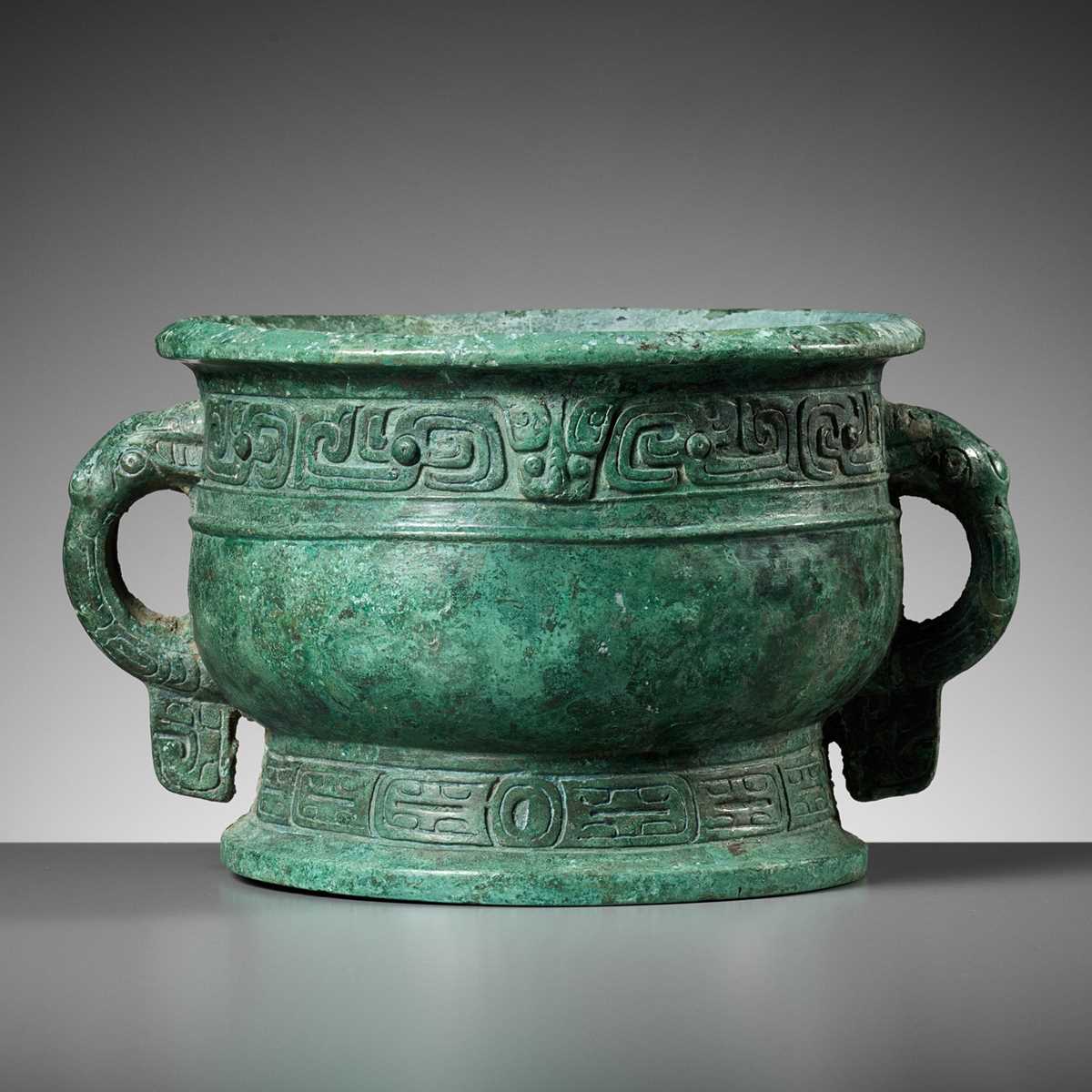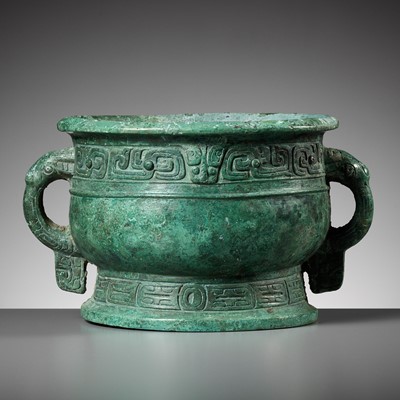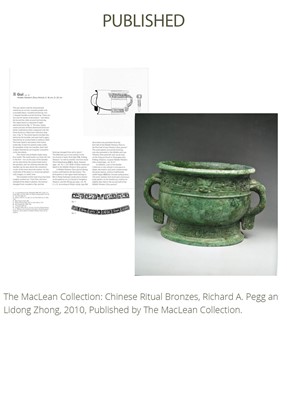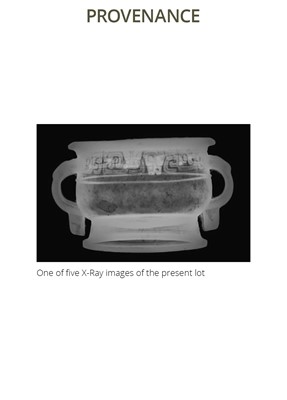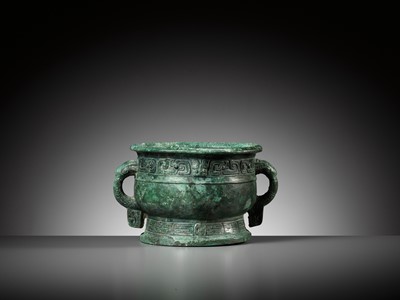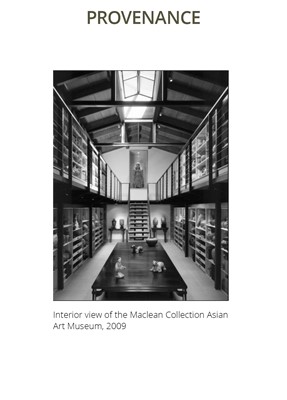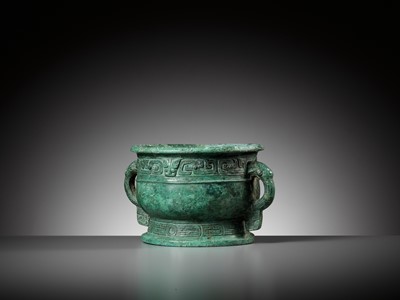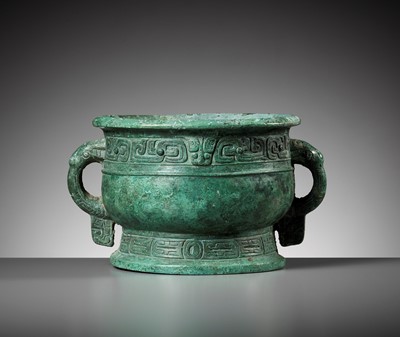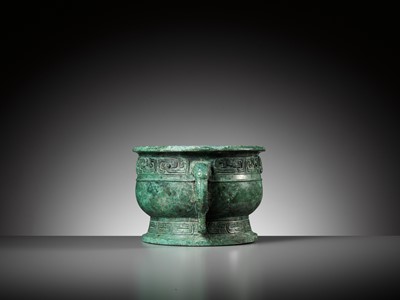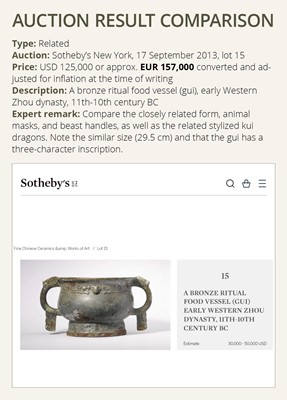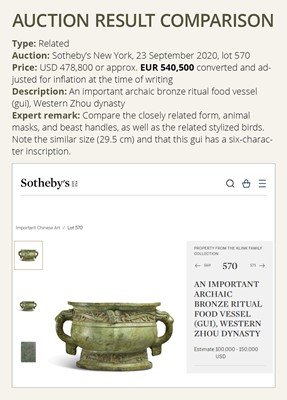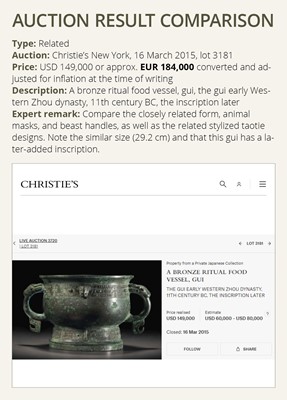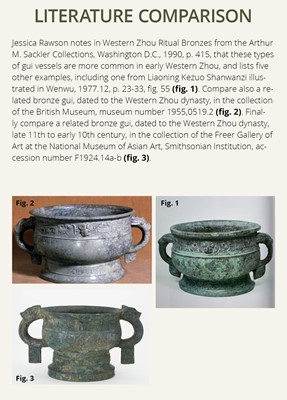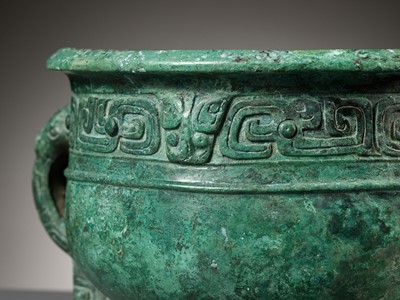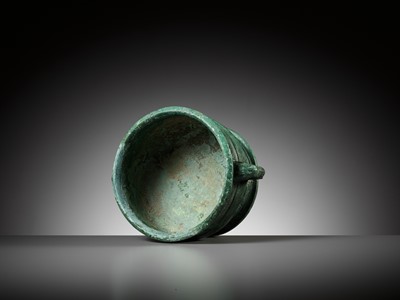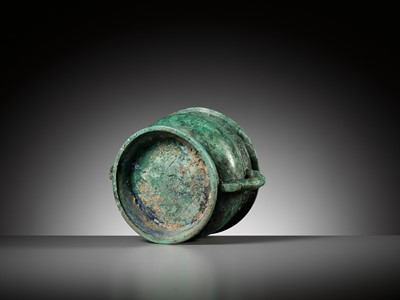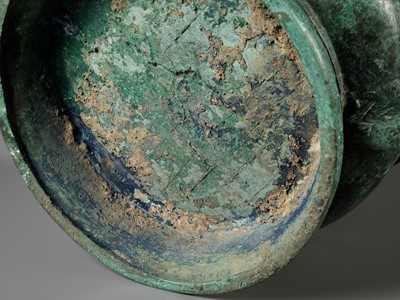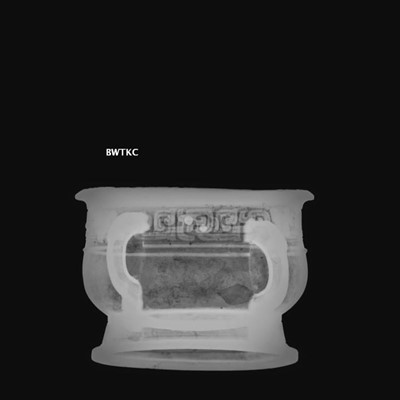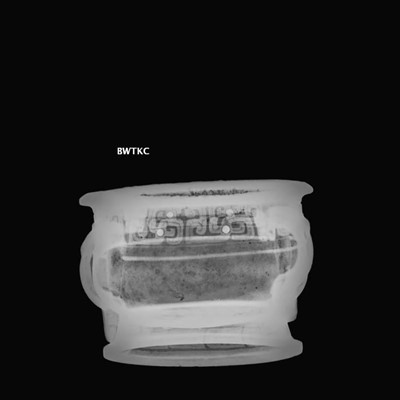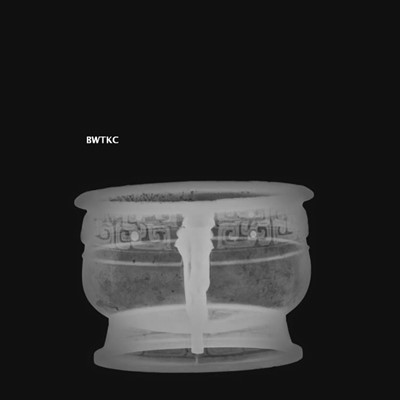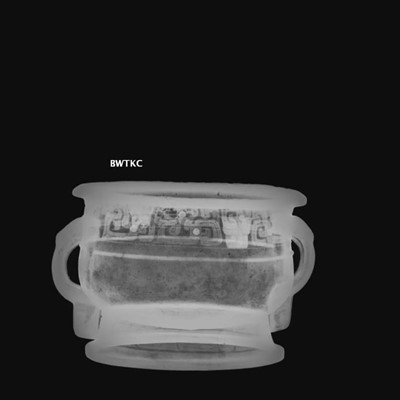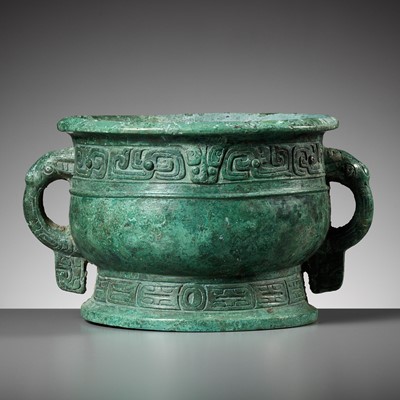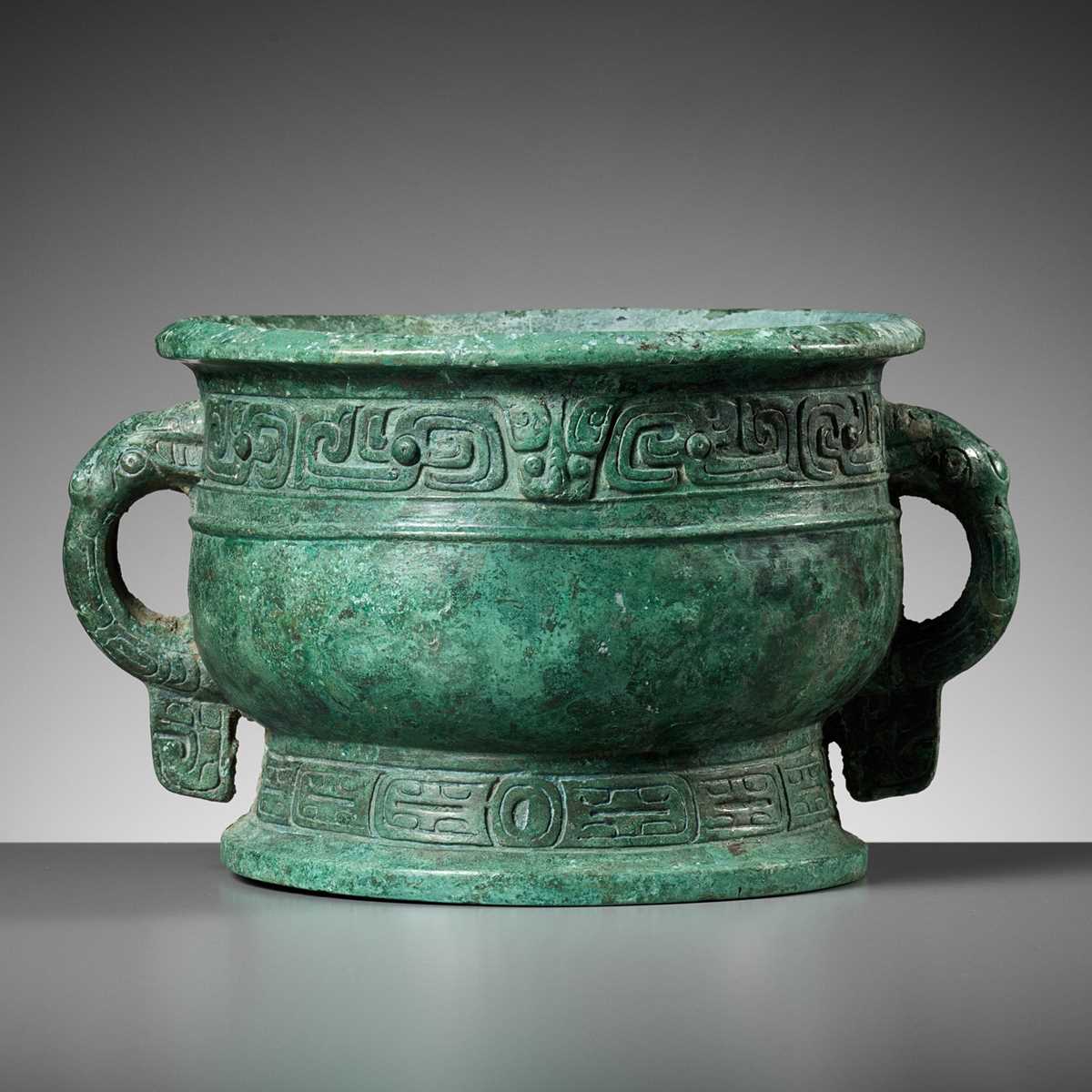13th Dec, 2023 13:00
Fine Asian Art Holiday Sale
92
AN ARCHAIC BRONZE RITUAL FOOD VESSEL, GUI, WESTERN ZHOU DYNASTY
西周青銅夔紋簋
Sold for €33,800
including Buyer's Premium
China, 11th-10th century BC. Well cast with the compressed body resting on a tall splayed foot, decorated below the gently everted rim with a band of stylized mythical birds, the two pairs on the main sides centered by an animal mask cast in high relief, the other two centered on the horned animal heads that surmount the handles, all above a bowstring band, the foot with a geometric band. The beast handles are neatly incised and set with pendent tabs.
Provenance: The MacLean Collection of Asian Art Museum, acquired 1996 in Hong Kong and deaccessioned in 2022. The MacLean Collection has been formed over the last fifty years by Barry MacLean, a businessman from Chicago, who began to collect in the early 1970s. Over time, he made many trips to Asia for business, and began to narrow his focus to ancient bronzes from China and their archaistic counterparts from later dynasties. The MacLean Collection of Asian Art is housed in a museum which was designed by Larry Booth and completed in 2003. Since 2004, the museum has published seven books, held thirteen exhibitions, lent objects to many other museums, and awarded a dozen fellowships to train future specialists and enthusiasts.
Published: Richard A. Pegg and Zhang Lidong, The MacLean Collection: Chinese Ritual Bronzes, Chicago, 2010, pl. 19.
Condition: Very good condition, commensurate with age. The vessel is slightly leaning and has some old wear as well as minor casting flaws, minuscule nicks, and small dents. The lower body has two small fills, invisible to the naked eye, but precisely detected on the five X-ray images provided (available in the online catalog at www.zacke.at or via e-mail upon request). Spectacular, naturally grown patina overall with several layers of malachite encrustation and small areas of azurite and cuprite. The crisply cast decorations are extremely well-preserved, which makes this one of the most attractive examples of its kind. In such pristine condition, it must be considered exceedingly rare.
Weight: 2,878 g
Dimensions: Width 28 cm (across handles)
Gui were used during ritual ceremonies for storing cooked rice or millet. While this vessel shape first appeared in the Erligang phase, they were not widely produced and examples from this period are rare. The form increased in popularity from the early Western Zhou dynasty onwards, and numerous variations of the original shape also began to appear. The present vessel, with its rounded body, everted rim and animal-head handles represents the most popular form.
Literature comparison:
A related gui unearthed from Xi’an, Shaanxi province, now in the National Museum of China, Beijing, is illustrated in Zhongguo qingtongqi quanji [Complete collection of Chinese archaic bronzes], vol. 5, Beijing, 1996, pl. 61. Another from the collection of T. Yamamoto is published in Sueji Umehara, Nihon Schūcho Shina kodō Seikwa/ Selected Relics of Ancient Chinese Bronzes from Collections in Japan, vol. 2, Osaka, 1960, pl. 107. Jessica Rawson notes in Western Zhou Ritual Bronzes from the Arthur M. Sackler Collections, Washington D.C., 1990, p. 415, that these types of gui vessels are more common in early Western Zhou, and lists five other examples, including one from Liaoning Kezuo Shanwanzi illustrated in Wenwu, 1977.12, p. 23-33, fig. 55. Compare also a related bronze gui, dated to the Western Zhou dynasty, in the collection of the British Museum, museum number 1955,0519.2. Finally compare a related bronze gui, dated to the Western Zhou dynasty, late 11th to early 10th century, in the collection of the Freer Gallery of Art at the National Museum of Asian Art, Smithsonian Institution, accession number F1924.14a-b.
Auction result comparison:
Type: Related
Auction: Sotheby’s New York, 23 September 2020, lot 570
Price: USD 478,800 or approx. EUR 540,500 converted and adjusted for inflation at the time of writing
Description: An important archaic bronze ritual food vessel (gui), Western Zhou dynasty
Expert remark: Compare the closely related form, animal masks, and beast handles, as well as the related stylized birds. Note the similar size (29.5 cm) and that this gui has a six-character inscription.
Auction result comparison:
Type: Related
Auction: Sotheby’s New York, 17 September 2013, lot 15
Price: USD 125,000 or approx. EUR 157,000 converted and adjusted for inflation at the time of writing
Description: A bronze ritual food vessel (gui), early Western Zhou dynasty, 11th-10th century BC
Expert remark: Compare the closely related form, animal masks, and beast handles, as well as the related stylized kui dragons. Note the similar size (29.5 cm) and that the gui has a three-character inscription.
Auction result comparison:
Type: Related
Auction: Christie’s New York, 16 March 2015, lot 3181
Price: USD 149,000 or approx. EUR 184,000 converted and adjusted for inflation at the time of writing
Description: A bronze ritual food vessel, gui, the gui early Western Zhou dynasty, 11th century BC, the inscription later
Expert remark: Compare the closely related form, animal masks, and beast handles, as well as the related stylized taotie designs. Note the similar size (29.2 cm) and that this gui has a later-added inscription.
西周青銅夔紋簋
中國,公元前十一至十世紀。圓簋,折沿,雙耳,圓腹,圈足,耳做獸首形,下有附珥,圈足外有外凸的圈足座。口沿下有一圈有夔紋與獸面紋飾帶,器腹素面,足部飾橫條紋。
來源:亞洲藝術博物館MacLean 收藏,1996年購於香港,2022年撤出收藏。MacLean 收藏由來自芝加哥的商人 Barry MacLean 在50 年前創立,他於 1970 年代初開始收藏。他曾多次前往亞洲從商,並開始將注意力集中在來自中國的古代青銅器和後世的仿古青銅器上。The MacLean Collection由Larry Booth設計並於 2003 年完工。自 2004年以來,該博物館已出版了七本書,舉辦了十三次展覽,將藏品借給許多其他博物館,並用十幾個獎學金來培訓未來的專家和愛好者。
出版:Richard A. Pegg 與張立東,The MacLean Collection: Chinese Ritual Bronzes,芝加哥,2010年,圖19。
品相:狀況極好,容器略微傾斜,有一些磨損以及輕微的鑄造缺陷、微小的刻痕和小凹痕。簋下半部分有兩個肉眼看不見的小填充物,但在所提供的五張 X 射線圖像上可以精確檢測到(可在www.zacke.at的在線目錄中找到或通過電子郵件索取)。自然生長的銅綠包漿整體帶有幾層孔雀石綠色結殼和小面積的紅藍斑。清晰明快的鑄造裝飾保存得非常好,這使它極具吸引力。如此原始的狀態,是極其罕見的。
重量:2,878 克
尺寸:兩耳之間寬28 厘米
簋相當於今天的碗,是商周時期的盛飯工具。文獻中説是用來盛黍稷稻粱的器皿。這種器型曾出現在二里崗文化中。青銅簋出現在商代早期,但數量較少,商晚期逐漸增加。商周時期,簋是重要的禮器。
文獻比較:
一件相近的青銅簋,出土於陝西西安,現藏於北京中國國家博物館,見《中國青銅器全集》,卷五,北京,1996年,編號61。另一件收藏於T. Yamamoto,見歐米蒐儲,《支那古銅精華》,卷二,大阪,1960年,編號107。Jessica Rawson在 《Western Zhou Ritual Bronzes from the Arthur M. Sackler Collections》,華盛頓D.C.,1990年,頁415,寫道「此種類型的簋較常見於西周早期」,她也列出了五個例子,包含一件出土於遼寧喀左山灣子的簋,見《文物》,1977年12月,頁23-33,圖55。 比較一件相近的西周青銅簋,收藏於大英博物館,編號1955,0519.2。最後比較一件相近的西周公元前十一世紀晚期至十世紀早期青銅簋 ,收藏於亞瑟·M·賽克勒美術館Freer Gallery of Art,史密森尼學會,編號F1924.14a-b。
拍賣結果比較:
形制:相近
拍賣:紐約蘇富比,2020年9月23日,lot 570
價格:USD 478,800(相當於今日EUR 540,500)
描述:西周侁簋
專家評論:比較非常相近外型、獸面紋和獸輔首,以及相近的鳥紋。請注意相似的尺寸(29.5厘米),以及此簋有六字款識。
拍賣結果比較:
形制:相近
拍賣:紐約蘇富比,2013年9月17日,lot 15
價格:USD 125,000(相當於今日EUR 157,000)
描述:西周早期公元前十世紀青銅夔龍紋簋
專家評論:比較非常相近外型、獸面紋和獸輔首,以及相近的夔紋。請注意相似的尺寸(29.5厘米) ,以及此簋有三字款識。
拍賣結果比較:
形制:相近
拍賣:紐約佳士得,2015年3月16日,lot 3181
價格:USD 149,000(相當於今日EUR 184,000)
描述:西周早期青銅饕餮紋簋,後刻銘文
專家評論:比較非常相近外型、獸面紋和獸輔首,以及相近的饕餮紋。請注意相似的尺寸(29.2厘米), 以及此簋有後刻的款識。
China, 11th-10th century BC. Well cast with the compressed body resting on a tall splayed foot, decorated below the gently everted rim with a band of stylized mythical birds, the two pairs on the main sides centered by an animal mask cast in high relief, the other two centered on the horned animal heads that surmount the handles, all above a bowstring band, the foot with a geometric band. The beast handles are neatly incised and set with pendent tabs.
Provenance: The MacLean Collection of Asian Art Museum, acquired 1996 in Hong Kong and deaccessioned in 2022. The MacLean Collection has been formed over the last fifty years by Barry MacLean, a businessman from Chicago, who began to collect in the early 1970s. Over time, he made many trips to Asia for business, and began to narrow his focus to ancient bronzes from China and their archaistic counterparts from later dynasties. The MacLean Collection of Asian Art is housed in a museum which was designed by Larry Booth and completed in 2003. Since 2004, the museum has published seven books, held thirteen exhibitions, lent objects to many other museums, and awarded a dozen fellowships to train future specialists and enthusiasts.
Published: Richard A. Pegg and Zhang Lidong, The MacLean Collection: Chinese Ritual Bronzes, Chicago, 2010, pl. 19.
Condition: Very good condition, commensurate with age. The vessel is slightly leaning and has some old wear as well as minor casting flaws, minuscule nicks, and small dents. The lower body has two small fills, invisible to the naked eye, but precisely detected on the five X-ray images provided (available in the online catalog at www.zacke.at or via e-mail upon request). Spectacular, naturally grown patina overall with several layers of malachite encrustation and small areas of azurite and cuprite. The crisply cast decorations are extremely well-preserved, which makes this one of the most attractive examples of its kind. In such pristine condition, it must be considered exceedingly rare.
Weight: 2,878 g
Dimensions: Width 28 cm (across handles)
Gui were used during ritual ceremonies for storing cooked rice or millet. While this vessel shape first appeared in the Erligang phase, they were not widely produced and examples from this period are rare. The form increased in popularity from the early Western Zhou dynasty onwards, and numerous variations of the original shape also began to appear. The present vessel, with its rounded body, everted rim and animal-head handles represents the most popular form.
Literature comparison:
A related gui unearthed from Xi’an, Shaanxi province, now in the National Museum of China, Beijing, is illustrated in Zhongguo qingtongqi quanji [Complete collection of Chinese archaic bronzes], vol. 5, Beijing, 1996, pl. 61. Another from the collection of T. Yamamoto is published in Sueji Umehara, Nihon Schūcho Shina kodō Seikwa/ Selected Relics of Ancient Chinese Bronzes from Collections in Japan, vol. 2, Osaka, 1960, pl. 107. Jessica Rawson notes in Western Zhou Ritual Bronzes from the Arthur M. Sackler Collections, Washington D.C., 1990, p. 415, that these types of gui vessels are more common in early Western Zhou, and lists five other examples, including one from Liaoning Kezuo Shanwanzi illustrated in Wenwu, 1977.12, p. 23-33, fig. 55. Compare also a related bronze gui, dated to the Western Zhou dynasty, in the collection of the British Museum, museum number 1955,0519.2. Finally compare a related bronze gui, dated to the Western Zhou dynasty, late 11th to early 10th century, in the collection of the Freer Gallery of Art at the National Museum of Asian Art, Smithsonian Institution, accession number F1924.14a-b.
Auction result comparison:
Type: Related
Auction: Sotheby’s New York, 23 September 2020, lot 570
Price: USD 478,800 or approx. EUR 540,500 converted and adjusted for inflation at the time of writing
Description: An important archaic bronze ritual food vessel (gui), Western Zhou dynasty
Expert remark: Compare the closely related form, animal masks, and beast handles, as well as the related stylized birds. Note the similar size (29.5 cm) and that this gui has a six-character inscription.
Auction result comparison:
Type: Related
Auction: Sotheby’s New York, 17 September 2013, lot 15
Price: USD 125,000 or approx. EUR 157,000 converted and adjusted for inflation at the time of writing
Description: A bronze ritual food vessel (gui), early Western Zhou dynasty, 11th-10th century BC
Expert remark: Compare the closely related form, animal masks, and beast handles, as well as the related stylized kui dragons. Note the similar size (29.5 cm) and that the gui has a three-character inscription.
Auction result comparison:
Type: Related
Auction: Christie’s New York, 16 March 2015, lot 3181
Price: USD 149,000 or approx. EUR 184,000 converted and adjusted for inflation at the time of writing
Description: A bronze ritual food vessel, gui, the gui early Western Zhou dynasty, 11th century BC, the inscription later
Expert remark: Compare the closely related form, animal masks, and beast handles, as well as the related stylized taotie designs. Note the similar size (29.2 cm) and that this gui has a later-added inscription.
西周青銅夔紋簋
中國,公元前十一至十世紀。圓簋,折沿,雙耳,圓腹,圈足,耳做獸首形,下有附珥,圈足外有外凸的圈足座。口沿下有一圈有夔紋與獸面紋飾帶,器腹素面,足部飾橫條紋。
來源:亞洲藝術博物館MacLean 收藏,1996年購於香港,2022年撤出收藏。MacLean 收藏由來自芝加哥的商人 Barry MacLean 在50 年前創立,他於 1970 年代初開始收藏。他曾多次前往亞洲從商,並開始將注意力集中在來自中國的古代青銅器和後世的仿古青銅器上。The MacLean Collection由Larry Booth設計並於 2003 年完工。自 2004年以來,該博物館已出版了七本書,舉辦了十三次展覽,將藏品借給許多其他博物館,並用十幾個獎學金來培訓未來的專家和愛好者。
出版:Richard A. Pegg 與張立東,The MacLean Collection: Chinese Ritual Bronzes,芝加哥,2010年,圖19。
品相:狀況極好,容器略微傾斜,有一些磨損以及輕微的鑄造缺陷、微小的刻痕和小凹痕。簋下半部分有兩個肉眼看不見的小填充物,但在所提供的五張 X 射線圖像上可以精確檢測到(可在www.zacke.at的在線目錄中找到或通過電子郵件索取)。自然生長的銅綠包漿整體帶有幾層孔雀石綠色結殼和小面積的紅藍斑。清晰明快的鑄造裝飾保存得非常好,這使它極具吸引力。如此原始的狀態,是極其罕見的。
重量:2,878 克
尺寸:兩耳之間寬28 厘米
簋相當於今天的碗,是商周時期的盛飯工具。文獻中説是用來盛黍稷稻粱的器皿。這種器型曾出現在二里崗文化中。青銅簋出現在商代早期,但數量較少,商晚期逐漸增加。商周時期,簋是重要的禮器。
文獻比較:
一件相近的青銅簋,出土於陝西西安,現藏於北京中國國家博物館,見《中國青銅器全集》,卷五,北京,1996年,編號61。另一件收藏於T. Yamamoto,見歐米蒐儲,《支那古銅精華》,卷二,大阪,1960年,編號107。Jessica Rawson在 《Western Zhou Ritual Bronzes from the Arthur M. Sackler Collections》,華盛頓D.C.,1990年,頁415,寫道「此種類型的簋較常見於西周早期」,她也列出了五個例子,包含一件出土於遼寧喀左山灣子的簋,見《文物》,1977年12月,頁23-33,圖55。 比較一件相近的西周青銅簋,收藏於大英博物館,編號1955,0519.2。最後比較一件相近的西周公元前十一世紀晚期至十世紀早期青銅簋 ,收藏於亞瑟·M·賽克勒美術館Freer Gallery of Art,史密森尼學會,編號F1924.14a-b。
拍賣結果比較:
形制:相近
拍賣:紐約蘇富比,2020年9月23日,lot 570
價格:USD 478,800(相當於今日EUR 540,500)
描述:西周侁簋
專家評論:比較非常相近外型、獸面紋和獸輔首,以及相近的鳥紋。請注意相似的尺寸(29.5厘米),以及此簋有六字款識。
拍賣結果比較:
形制:相近
拍賣:紐約蘇富比,2013年9月17日,lot 15
價格:USD 125,000(相當於今日EUR 157,000)
描述:西周早期公元前十世紀青銅夔龍紋簋
專家評論:比較非常相近外型、獸面紋和獸輔首,以及相近的夔紋。請注意相似的尺寸(29.5厘米) ,以及此簋有三字款識。
拍賣結果比較:
形制:相近
拍賣:紐約佳士得,2015年3月16日,lot 3181
價格:USD 149,000(相當於今日EUR 184,000)
描述:西周早期青銅饕餮紋簋,後刻銘文
專家評論:比較非常相近外型、獸面紋和獸輔首,以及相近的饕餮紋。請注意相似的尺寸(29.2厘米), 以及此簋有後刻的款識。
Zacke Live Online Bidding
Our online bidding platform makes it easier than ever to bid in our auctions! When you bid through our website, you can take advantage of our premium buyer's terms without incurring any additional online bidding surcharges.
To bid live online, you'll need to create an online account. Once your account is created and your identity is verified, you can register to bid in an auction up to 12 hours before the auction begins.
Intended Spend and Bid Limits
When you register to bid in an online auction, you will need to share your intended maximum spending budget for the auction. We will then review your intended spend and set a bid limit for you. Once you have pre-registered for a live online auction, you can see your intended spend and bid limit by going to 'Account Settings' and clicking on 'Live Bidding Registrations'.
Your bid limit will be the maximum amount you can bid during the auction. Your bid limit is for the hammer price and is not affected by the buyer’s premium and VAT. For example, if you have a bid limit of €1,000 and place two winning bids for €300 and €200, then you will only be able to bid €500 for the rest of the auction. If you try to place a bid that is higher than €500, you will not be able to do so.
Online Absentee and Telephone Bids
You can now leave absentee and telephone bids on our website!
Absentee Bidding
Once you've created an account and your identity is verified, you can leave your absentee bid directly on the lot page. We will contact you when your bids have been confirmed.
Telephone Bidding
Once you've created an account and your identity is verified, you can leave telephone bids online. We will contact you when your bids have been confirmed.
Classic Absentee and Telephone Bidding Form
You can still submit absentee and telephone bids by email or fax if you prefer. Simply fill out the Absentee Bidding/Telephone bidding form and return it to us by email at office@zacke.at or by fax at +43 (1) 532 04 52 20. You can download the PDF from our Upcoming Auctions page.
How-To Guides
How to Create Your Personal Zacke Account
How to Register to Bid on Zacke Live
How to Leave Absentee Bids Online
How to Leave Telephone Bids Online
中文版本的操作指南
创建新账号
注册Zacke Live在线直播竞拍(免平台费)
缺席投标和电话投标
Third-Party Bidding
We partner with best-in-class third-party partners to make it easy for you to bid online in the channel of your choice. Please note that if you bid with one of our third-party online partners, then there will be a live bidding surcharge on top of your final purchase price. You can find all of our fees here. Here's a full list of our third-party partners:
- 51 Bid Live
- EpaiLive
- ArtFoxLive
- Invaluable
- LiveAuctioneers
- the-saleroom
- lot-tissimo
- Drouot
Please note that we place different auctions on different platforms. For example, in general, we only place Chinese art auctions on 51 Bid Live.
Bidding in Person
You must register to bid in person and will be assigned a paddle at the auction. Please contact us at office@zacke.at or +43 (1) 532 04 52 for the latest local health and safety guidelines.
